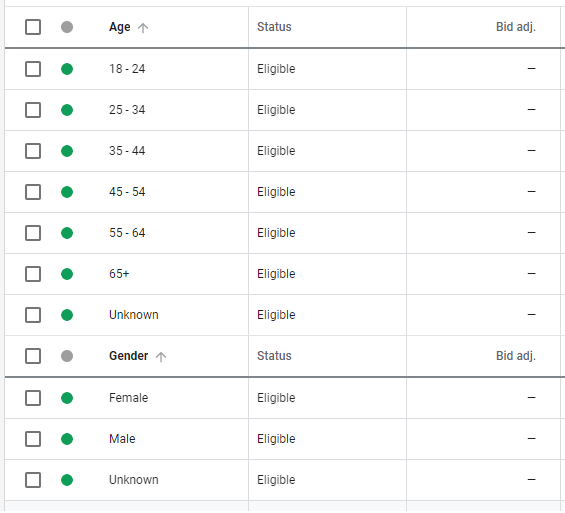“Everyone Is Not Your Customer”
-Seth Godin
Let’s play a game called “Guess Who”. From seeing a search query, you will guess the user’s age and gender.
![]()
One more thing—every time you guess incorrectly, it will cost you $5.00. Having second thoughts?
This may be an interesting game from a sociological standpoint, but for a business, this is a classic example of setting yourself up to fail. Making semi-educated guesses without a significant amount of actionable data usually leads marketers to lose their business’ money.
So, let’s get back to basics.
Every sound business plan starts with one of the key principles of marketing: know your target audience. In our ever-growing industry, this is more important than ever. Competition is fierce, and when you can almost hear the CPCs rising, focus on working smarter, not harder.
Make sure to use Google Ads’ Age and Gender Targeting options to narrow your target audience by adding bid adjustments. These raise or lower the amount you are willing to pay for ads served to a specific demographic. Existing data makes it clear which demographics perform better than others. Numbers don’t lie. Your data is already there. Guessing will limit your ROI. The bids are just waiting to be modified for your gender & age group target audience.
Lower your bid adjustments for demographics that are unlikely to buy your product, or exclude these audiences altogether. Then try raising bids on the best-performing segments.

Let’s use the leather jacket example again.
If you are dealing with a company that designs jackets specifically for men, then you have a few options regarding gender audience targeting. For example, you could:
- Completely exclude women from your audience. Any users who Google believes are women will not see your ads.
- Add a bid modifier of -50% for women. If we assume that women are less likely to buy mens’ jackets, you can pay less for their clicks but still serve them ads.
- Determine whether women buy jackets at the same rate as men, and if so, leave the bid modifier as is. By ruling out customers without sufficient data to support the decision, you risk missing out on a potentially significant source of revenue.
- Add a positive bid modifier if you see that women actually convert at a higher rate than men. Maybe these leather jackets are popular gifts.
Age is another powerful metric for analyzing and targeting your ideal target audience. For example, you could:
- Raise bids on users in the 45-54 age group if they are more likely to purchase your jackets.
- Exclude users under the age of 25 if you see that they are driving costs up by clicking on ads but not converting.
Age and gender targeting groups can also be combined. For example, if your analysis shows that men aged 18-24 convert at the highest rate, you may want to raise the bid modifier and spend more money serving ads to that specific target age group.
All of these age and gender bid modifiers serve to optimize everyday spend and increase your ad account’s ROI.

If the marketplace never changed, this would be an easy business and we could all be rock stars.
Using audience age groups and gender targeting can help you achieve long-term success as you respond to changes in your data. Reviewing these changes regularly, even after your bid modifiers are in place, can help you fine-tune your strategy by identifying new target audiences and opportunities.
As trends change over time, there may be a new demographic open for prospecting. It’s hard to predict when you will have an upsurge in males aged 44-55 shopping for leather jackets, but if you pay attention to the data, you can capture a whole new demographic of paying customers.
Defining a target audience or ICP is one of the first and most significant stages of building a successful business strategy. Don’t waste time playing the guessing game. Leave that to your competitors!
Finding opportunities for growth doesn’t have to be difficult. Get a free competitive analysis from Titan Growth to discover how you can unlock your business’s potential.


